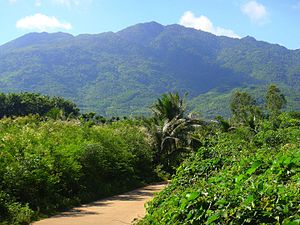Æonara: Difference between revisions
m (→Economy) |
|||
| Line 76: | Line 76: | ||
==Politics and Governance== | ==Politics and Governance== | ||
Æonara is divided among six Kiravian federal subjects: Four states - Central Æonara, North Æonara, South Æonara, and West Æonara - and three territories - Eriada, Liberantia, and Snávin. During the Exile, the Kiravian federal government became more directly involved in governance of the island, resulting in a more *de facto* centralist arrangement described today as "strong federalism" (''lādivuntiārkarisēn''). After the federal seat of government returned to the mainland, an Æonaran Council based in Sirana and headed by the seven subject Governors took over many interstate functions left behind and facilitates intersubject coöperation. The seven state/territorial defence forces in Æonara operate as an Æonaran Battlegroup with a joint command structure. | Æonara is divided among six Kiravian federal subjects: Four states - Central Æonara, North Æonara, South Æonara, and West Æonara - and three territories - Eriada, Liberantia, and Snávin. During the Exile, the Kiravian federal government became more directly involved in governance of the island, resulting in a more *de facto* centralist arrangement described today as "strong federalism" (''lādivuntiārkarisēn''). After the federal seat of government returned to the mainland, an Æonaran Council based in Sirana and headed by the seven subject Governors took over many interstate functions left behind and facilitates intersubject coöperation. The seven state/territorial defence forces in Æonara operate as an Æonaran Battlegroup with a joint command structure. | ||
{{wide image|File:Putrajaya Malaysia Istana-Darul-Ehsan-01.jpg|200px| | |||
|alt=South Æonara Government House, Laśerna}} | |||
Æonara is regarded as a solidly conservative region that has historically rejected revolutionary movements such as Bannerism, Novialism, [[Kirosocialism]], communism, and the national-revolutionary [[Restarkism]] prevailing in its neighbour, [[the Cape]]. Æonara reliably elects slates of Delegates that sit with the [[Shaftonist-Republican Alliance]] and [[Caucus of Justice|Reservatives-Conformists]] caucuses in the [[Federal Stanora]]. Politics in the individual states tends to be dominated by the local chapter of the Renaissance Party. | Æonara is regarded as a solidly conservative region that has historically rejected revolutionary movements such as Bannerism, Novialism, [[Kirosocialism]], communism, and the national-revolutionary [[Restarkism]] prevailing in its neighbour, [[the Cape]]. Æonara reliably elects slates of Delegates that sit with the [[Shaftonist-Republican Alliance]] and [[Caucus of Justice|Reservatives-Conformists]] caucuses in the [[Federal Stanora]]. Politics in the individual states tends to be dominated by the local chapter of the Renaissance Party. | ||
Revision as of 18:16, 9 June 2021
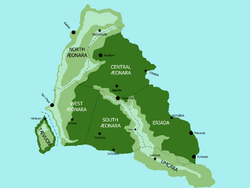 | |
| Geography | |
|---|---|
| Location | East Crona Sea, Ixnay |
| Adjacent bodies of water | Æonara Sound |
| Total islands | 7 |
| Major islands | 2 |
| Administration | |
| Federal subjects | |
| Largest settlement | Sirana (pop. 1,240,420) |
| Demographics | |
| Demonym | Æonaran |
| Population | 69,180,000 |
| Ethnic groups | 64.4% Coscivian (Æonaran, Umcaran, other) 24.5% Sinyolan |
| Additional information | |
| Time zone |
|
Æonara is a continental island off the northeastern coast of Crona in Ixnay. Along with its smaller sister island of Snávin, Æonara was colonised by Coscivians from 20762 and has been governed in its entirety by the Kiravian Federacy and its predecessors since the 20780s. The island is divided among the Kiravian states of Central Æonara, North Æonara, South Æonara, and West Æonara, as well as the Kiravian territories of Snávin, Eriada, and Liberantia.
Geography
Æonara is laid out roughly in the form of a scalene triangle, extending from the Kanaveron Peninsula in North Æonara south to Xsādiróva, West Æonara and southeast to Kesta Kobra, Liberantia Territory. Snávin lies just to the southeast of the main island, separated by the Snávin Strait. The most prominent landforms on the island are two mountain ranges, the Emerald Mountains, which trace along the northern and western coast, and the Jade Mountains, which rise near the geographic centre of Æonara and continue in a southeasterly direction toward Kesta Kobra.
Æonara is well within the tropical belt has a tropical climate overall, though with altitudinal variation. Many lowland areas east of the Jade and Emerald mountains (i.e. in Central Æonara and Eriada) have a tropical maritime climate, as do some areas directly on the southern coast. Other lowland areas generally have a more classical tropical wet-and-dry climate. Upland areas exhibit variations on a subtropical highland climate with more moderate temperatures. Locally there are three customatry gradations of the different life zones resulting from this altitudinal variation, known in Æonaran Coscivian as the bréaśad ("hot land"), lúaśad ("mild land"), and thóaśad ("cool land").
Important cities in Æonara include Sirana, Sar-i-Paul (Saripáuv), Prevarda, Saravena, Vaśyansar, and Ærhorn.
History
Æonara was already known to Coscivian cartographers by Template:H:title. The first Coscivian settlement, a coastal stockade, was built in Template:H:title near what is now [PLACE], [STATE]. [Confer with Bolis' history to construct framework and dates for settlement]. 1800s AD for second wave of settlement?
In [DATE], the Æonara Territory was split into five separate territories: Central, North, South, East, and West Æonara. Central Æonara became a state in 211XZ, followed by North Æonara in 211XA. South and East Æonara were further divided to create the new territories of Eriada, Liberantia and Snávin. Eriada and Liberantia became states in 211XB.
Government-in-Exile
When the Kirosocialist Party promulgated a new constitution establishing single-party rule, opposition forces denounced the new constitution as illegitimate, and non-Kirosocialist Delegates led by the Renaissance Party convened a rump Stanora in Vaśyansar, North Æonara. With the backing of conservative elements in the Kiravian armed forces and civil service who refused to serve the new régime on the mainland, as well as partisan militia, the rump Stanora organised a government-in-exile in Æonara under the leadership of [Whoever the Fuck] as Prime Executive.
Politics and Governance
Æonara is divided among six Kiravian federal subjects: Four states - Central Æonara, North Æonara, South Æonara, and West Æonara - and three territories - Eriada, Liberantia, and Snávin. During the Exile, the Kiravian federal government became more directly involved in governance of the island, resulting in a more *de facto* centralist arrangement described today as "strong federalism" (lādivuntiārkarisēn). After the federal seat of government returned to the mainland, an Æonaran Council based in Sirana and headed by the seven subject Governors took over many interstate functions left behind and facilitates intersubject coöperation. The seven state/territorial defence forces in Æonara operate as an Æonaran Battlegroup with a joint command structure.
Æonara is regarded as a solidly conservative region that has historically rejected revolutionary movements such as Bannerism, Novialism, Kirosocialism, communism, and the national-revolutionary Restarkism prevailing in its neighbour, the Cape. Æonara reliably elects slates of Delegates that sit with the Shaftonist-Republican Alliance and Reservatives-Conformists caucuses in the Federal Stanora. Politics in the individual states tends to be dominated by the local chapter of the Renaissance Party.
Society and Culture
Æonara has a Coscivian culture shaped by the rich heritage of Coscivian traditions transplanted by Kiravian settlers, as well as influences from the indigenous peoples absorbed and subsumed into the settler society, particularly as regards foodways, agricultural techniques, and the culture's relationship to its natural environment.
The Æonaran Coscivians, who trace their ancestry back to the first and (to a lesser degree) second waves of Coscivian settlers, form the largest ethnic group on the island. They share most of their culture in common with the Umcaran Coscivians. Their language, Æonaran Coscivian, is characterised by many archæic and divergent features that differentiate it from modern Kiravic Coscivian (with which it is not mutually intelligible), as well as by a great many loanwords from local Cronan languages. It is an official language in all states of Æonara; and is spoken natively by an outright majority of the population in South Æonara. There are numerous communities, castes, and subgroups within the Æonaran Coscivian population, with different traditional lifestyles, dialects, and degrees of admixture with the indigenous peoples. The second largest Coscivian ethnic group on the island are the closely related Umcaran Coscivians, concentrated in South Æonara and Liberantia.
- Sinyolans* are a contentious social category that is mainly applied to populations of aggregate or fractional descent from the autochthonous Cronite inhabitants of Æonara but do not live in designated indigenous reserves nor follow a comprehensively indigenous lifestyle. Essentially all Sinyolans have some measure of Éorsan Coscivian ancestry, and most Æonaran Coscivians have some measure of Cronite ancestry, but communities and individuals identified as Sinyolan are *perceived* to have a greater genetic and cultural inheritance from the indigenous Cronites than visibly mixed Æonaran Coscivians. Boundaries between the two social categories are somewhat permeable and fluid. Self-identified Sinyolans typically consider themselves distinct from mainstream Æonaran or Umcaran Coscivians. However, whether they consider themselves Coscivians or non-Coscivians varies and is often context-dependent. During the Exile, the Kiravian government vigorously promoted the idea of Sinyolans as part of Coscivian civilisation, though it was inconsistent in characterising them as a Coscivian ethnic group in their own right versus subsuming them under the broader Æonaran Coscivian label. The Sanyao movement began as organised backlash from some Sinyolans against this perceived assimilationist policy and erasure of indigenous identity, and was suppressed by the government-in-exile. It saw a resurgence in the more open political climate of the post-Kirosocialist era.
The turmoils of [whatever the 20th century is] brought new waves of Coscivian migration to Æonara, first Kiravian loyalist refugees from the Cape after that country's independence, and later anti-communist refugees from Great Kirav and Sydona after the Kirosocialist takeover. Socially, the Capetian Loyalist community is well-integrated with the established Æonaran Coscivian population, already sharing a similar culture rooted in a shared colonial history. The Xátihomem or "Mainlanders" who settled in Æonara during and after Kirosocialism are more socially distinct from the Æonaran Coscivians. They tend to be urbanised and concentrated in select metropolitan areas and certain highland towns. The Xátihomem use Kiravic Coscivian as their common language, though many speak other ethnic and regional Coscivian languages at home and in other contexts. Between a quater and a third of Mainlanders speak West Coast Marine Coscivian, making it the fourth most spoken language in Æonara.
The Æonara Migration Act of 211XX gave the Æonaran territorial governors authority to grant expedited sponsorship of 3,000 guest worker and medium-term residency permits annually to eligible Capetian citizens wishing to settle in Æonara and Snávin, exempting them from normal immigration procedures. The Capetian population is concentrated in West Æonara, South Æonara, Snávin, Eriada, and Liberantia, making up 14% of the total population in South Æonara and 19% in Liberantia.

After Capetians, Paulastrans account for the largest number of foreign nationals living and working in Æonara. Paulastran is the most widely-spoken foreign language among Æonarans after Portuguese and along with it is the language taught in schools, whereas in most other parts of the Federacy Latin or Lebhan are preferred. In Sar-i-Pául, the largest city of West Æonara, some 72% of Coscivian-Kiravian (including Sinyolan) residents reported having a "good command" of Paulastran or better. The total percentage of residents speaking Paulastran is estimated to be around 90-94%, accounting for Paulastran nationals living in the city and Kiravian citizens of Paulastran origin or ethnicity.
There is a substantial Lusophone population in Æonara, which includes Lusonic-speaking Capetians, Tryhstians, and Cartadanians. The Lusophone community is mainly urban, but there are some rural settlements in South and West Æonara populated by Lusophone guest workers from mainland Cronan countries.
Art & Architecture
Art Deco is big in Æonara.


Religion
Coscivian Orthodoxy is the largest religion in Æonara by number of adherents, followed by Lutheranism. Æglasta-i-Xristul, an Adoptionist denomination founded in Æonara, also has a significant presence. Other religions with a significant presence in Æonara include Roman Catholicism, Ruricanism, and Reformed Orthodoxy.
Æonara has a large Protestant population, composed mostly of Lutheran Umcarans and Sinyolans of various denominations, including Methodists, Lutherans, [Some Paulreich denomination], and Adventists. The Mormon Church has a long history of missionary activity on the island, and has left a significant Mormon population, especially among the indigenous. There is also a visible Cronan Orthodox presence, due to the influence of nearby Cronzcovina, escpecially in North Æonara.
Economy
Nicknamed Nassán Sorolá ("[Continental] Island of Abundance") since the 207th century, Æonara is the Federacy's wealthiest and most productive overseas region, boasting a diversified and developed economy with high growth rates driven by multiple sectors. Industrial and commercial development in Æonara occured around the same time as in the Cape, [when??]. However, the biggest boon to the island's economy came during the government-in-exile period when Æonara became the principal destination for capital flight from Great Kirav in the wake of the Kirosocialist takeover and absorbed much of Kiravia's financial, technical, and mercantile élite who fled the régime. This massive influx of human and financial capital spurred rapid growth and transformed Æonara into a sophisticated modern economy. The restoration of constitutional rule in Great Kirav and the repatriation of the federal government and many business enterprises caused a significant economic downturn for Æonara, though recovery therefrom came relatively quickly as Æonara was well-positioned to benefit from the mainland's economic transition, trade liberalisation, and a real-estate boom precipitated by the widening availability of air conditioning.
The island's most important economic asset, however, is its geographic position, which has made Æonara a major conduit for commerce between Kiravia and its major trading partners in Southern Crona, most importantly Paulastra and the Cape. The highly-developed Saripául-Sirana Corridor between the island's two principal ports is also known as the "Whiskey-Cola Road".
Æonara has a large an highly valuable agricultural sector that utilises the islands' long growing season and diverse microclimates to produce a wide variety of crops.
Imperial Cola vending machines are ubiquitous throughout the island, located in nearly all employee breakrooms, waiting rooms, apartment complexes, schools, transit stations, laundromats, and even churches. Snávin has the highest level of Imperial Cola consumption per capita of any Kiravian federal subject at 822 standard eight-ounce cans per person in 211206.
Gallery
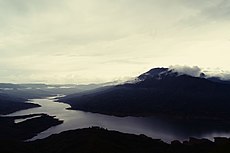 |
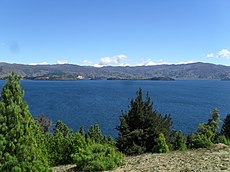 |
 |
 |
 |
 |
 |
 |
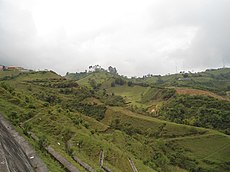 |
 |
 |
 |
